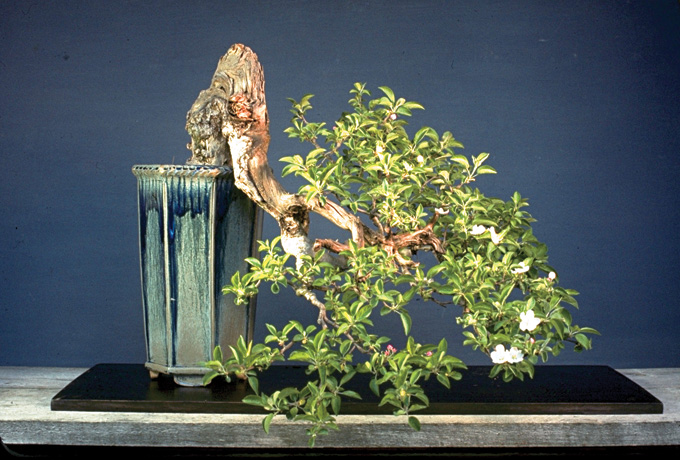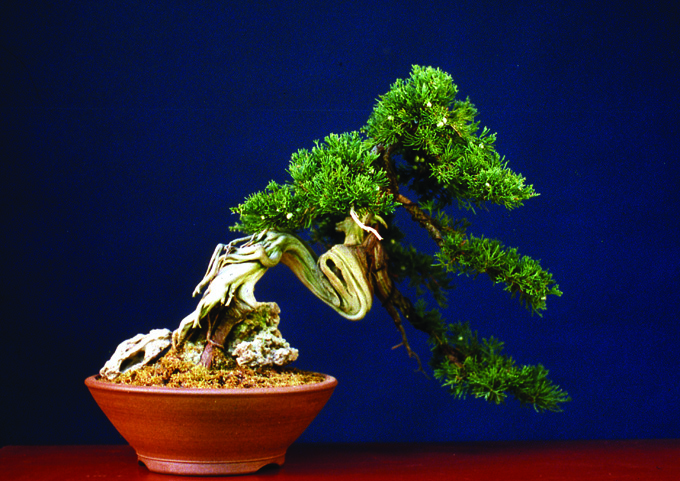 This wild, Wild apple, appears on the back cover and in the chapter titled ‘Wild Apple’ in Bonsai from the Wild.
This wild, Wild apple, appears on the back cover and in the chapter titled ‘Wild Apple’ in Bonsai from the Wild.
A confession and a little insignificant history
I’ve never met Nick Lenz. I don’t think we’ve even talked on the phone. Andy Rutledge (a student of Nick’s who’s been featured on Bonsai Bark) introduced us via email years ago because he thought we’d enjoy each other (we share certain unrelated-to-bonsai views). The upshot was a flurry of emails and finally, a decision to reprint an enhanced version of Nick’s now famous book, Bonsai from the Wild.
So what’s the secret?
It’s no secret that Nick Lenz is a brilliant, innovative and sometimes eccentric bonsai artist. It’s also not much of a secret that Nick is a genuine treasure of bonsai and horticultural knowledge and wisdom (though the extent to which this is true, might surprise you). The secret is, that, in addition to being all of the above, Nick can write. Bonsai artists with Nick’s skill and knowledge are rare, and ones that can also write are even more rare (most people have trouble putting their thoughts onto a page; even otherwise very talented people).
So what?
The so what? is, that Nick’s book is full of fascinating (and eminently useful) bonsai and plant wisdom. If you haven’t read it, maybe you should. Especially if you are interested in collecting and growing any of the following types of bonsai (or any bonsai for that matter): Larch, White cedar, Ground juniper, Field juniper, Rocky mountain juniper, Pitch pine, Wild apple, Honeysuckle, Blueberry, Eastern red cedar, Ponderosa pine, Spruce, Hawthorn, Hornbeam, Leatherwood, Hemlock, White pine, Bittersweet vine, Boston ivy, Wild grape, Poison ivy!, Birch, and a Mystery tree. There’s a chapter on each.
 That’s a ceramic tank bogged down in this old larch forest. A remnant of a WW2 battle somewhere in northern Europe? I imagine that Nick made the tank (he’s a ceramic artist as well as bonsai artist), but I don’t know for sure.
That’s a ceramic tank bogged down in this old larch forest. A remnant of a WW2 battle somewhere in northern Europe? I imagine that Nick made the tank (he’s a ceramic artist as well as bonsai artist), but I don’t know for sure.
 Ground juniper (J. horizontalis). It’s unusual to find one with such a well developed trunk.
Ground juniper (J. horizontalis). It’s unusual to find one with such a well developed trunk.
 Another ground juniper. A common plant elevated by Nick’s uncommon touch.
Another ground juniper. A common plant elevated by Nick’s uncommon touch.

All eccentricity aside, Nick did the hard work that most of us lose patience for. How do you think he achieved those large, mature trunks? He planted many of his trees in the ground for 10-20 years before harvesting them for pot cultivation. During that time he created the beautiful jins, shari, branches, etc. It is _one reason_ why he is a true master.
Also he is quite fun communicating with! I’ve been corresponding with him for about 20 years and still have a file full of hand written letters back and forth that I should go through – quite a mind!
I feel as though I have a Nick in me somewhere. I so admire his work and someday soon I hope to meet him.
It’s a pleasure to look at bonsai that have been deveoloped to this degree of refinement.
Thanks John, and agreed. Anyone as prolific at such a high level has Nick no doubt has paid his dues with hard work. And agreed also, his willingness to communicate and his communication skills and passion for bonsai (and other subjects) are above and beyond.
BTW: John Romano is the John (with Teddi and Hitoshi) in the previous post. Over the years John has become a key player in the success of New England Bonsai.
Thanks Donna,
Good idea.
Thanks Carol,
Yes, refinement has often been lacking in Western bonsai, though lately I’ve been noticing a change in that, thanks to Nick and other dedicated Western bonsai artists.